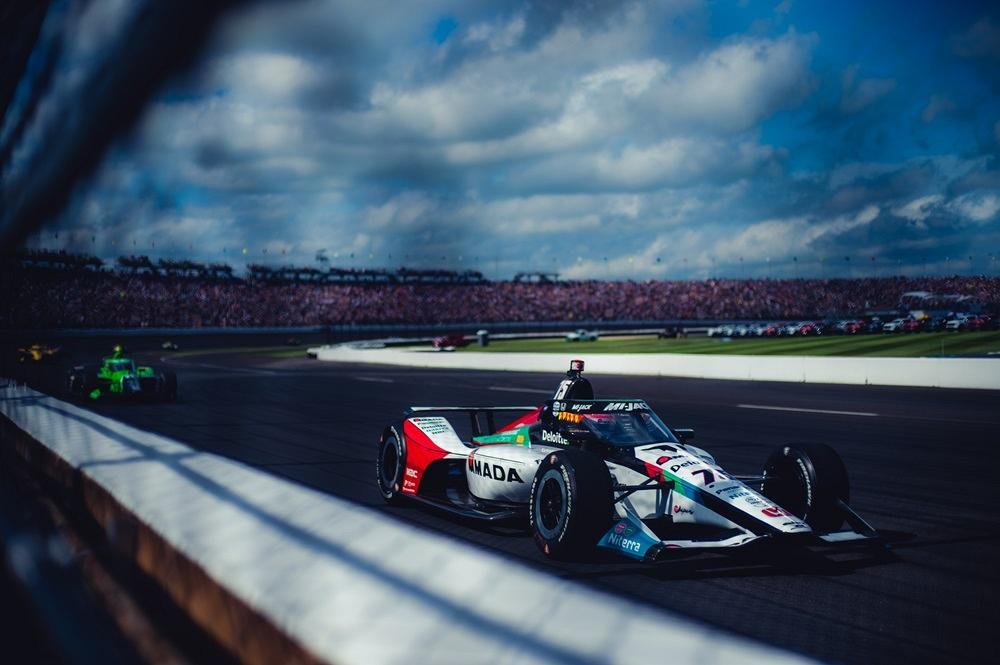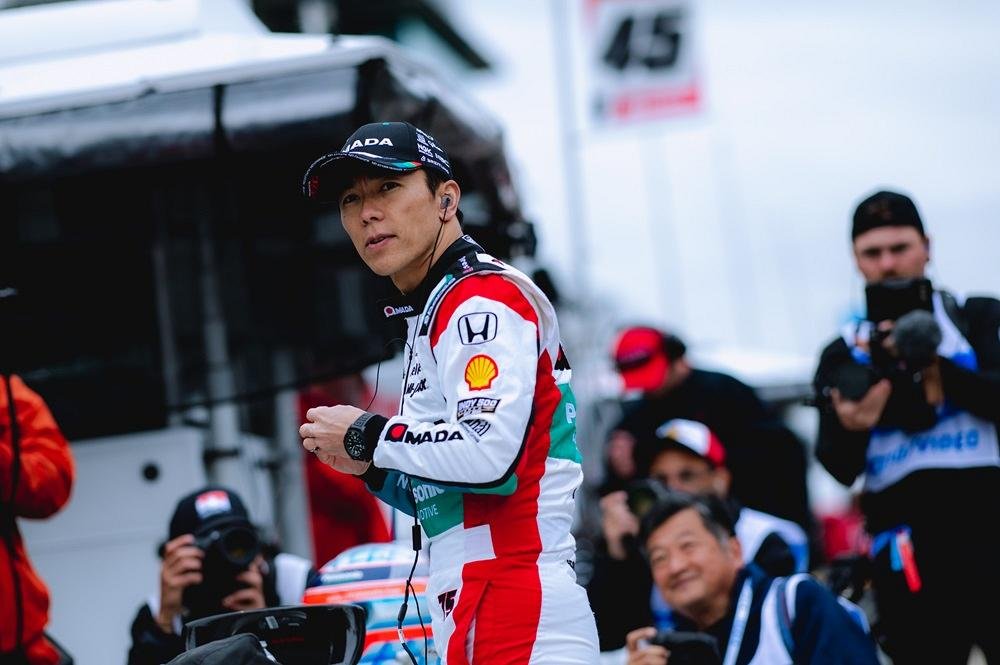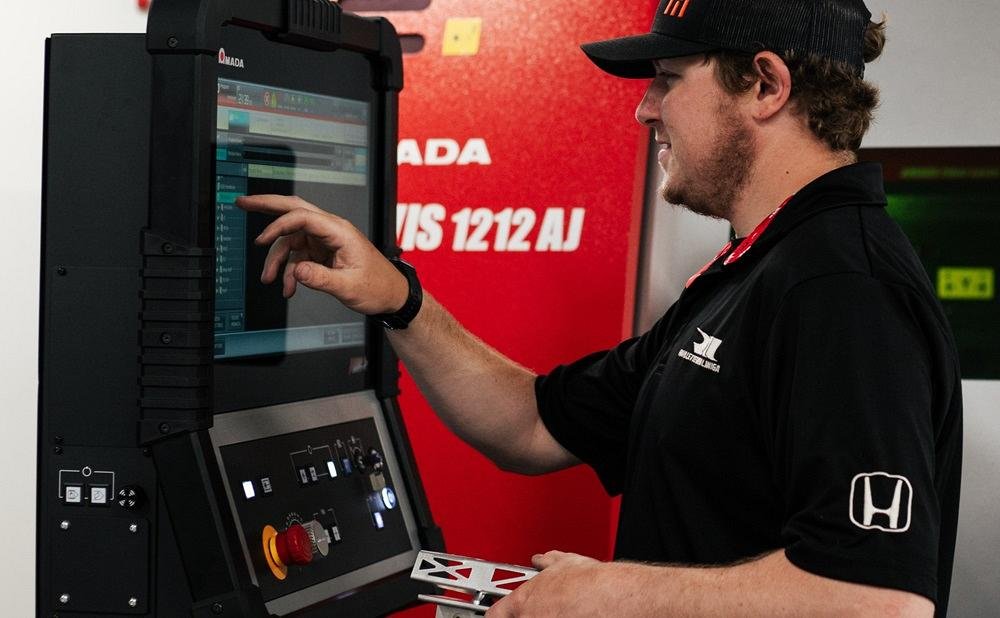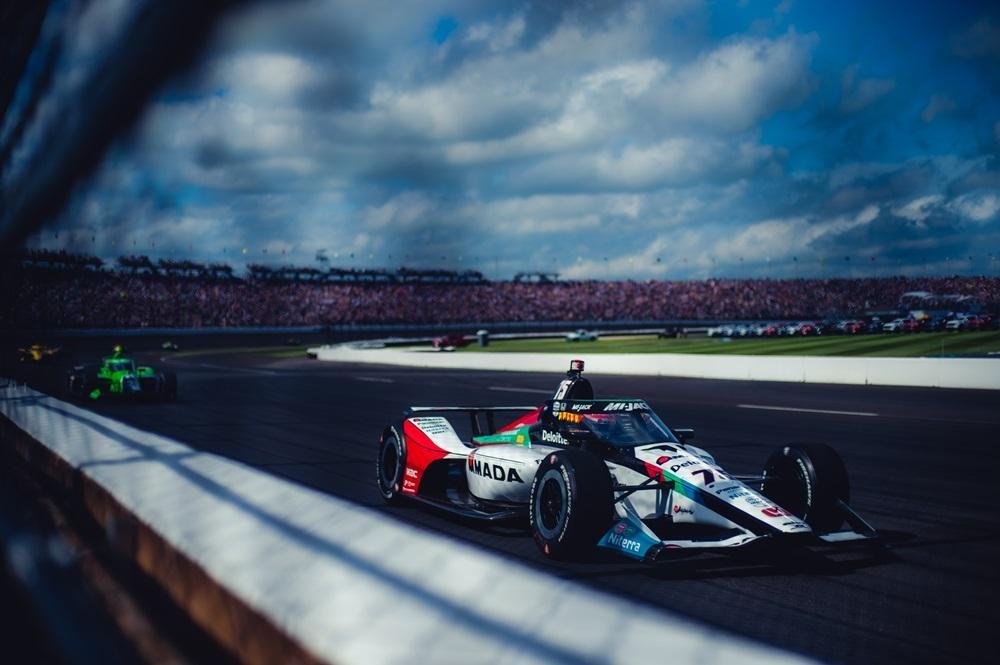
Takuma Sato’s No. 75 car, sponsored by AMADA, completes a turn at the 108th running of the Indianapolis 500. Rahal Letterman Lanigan Racing
Takuma Sato has a memorable mantra: No attack, no chance. The 2017 and 2020 IndyCar champion competed in this year’s storm-delayed Indianapolis 500. Tensions ran high as the clouds gathered and lightning struck, delaying start times and forcing race teams to implement long-planned what-if strategies. That included Japan’s racing icon “Taku” Sato, No. 75, from Rahal Letterman Lanigan (RLL) Racing, who drove a car sponsored by various Japanese companies, including a primary sponsor familiar to most in precision metal fabrication: AMADA.
Despite the weather, Indy still drew 300,000, the second-largest crowd the iconic race has seen in 100 years. All those eyeballs draw the sponsorships, of course. In many respects, the collaboration during and between events—and especially the thousands of hours of engineering, fabrication, and assembly—bears significant similarities to challenges and best practices in the metal fabrication business.
The goal, both in racing and in the broader realm of metal fabrication, is the same: iterative, continuous improvement, where everyone makes every second (or even tenth of a second) count. With technology’s endless march forward, Sato’s mantra is more apt than ever. If a fabricator accepts the status quo and doesn’t plan to move forward—or, as Sato would put it, if it never attacks—it has no chance.
Cut, Bend, Install, Done
During the week leading up to the big race, RLL engineers and mechanics knew something was amiss. They were using a modified exhaust system that, as they soon discovered, needed a new heat shield component. It was nothing fancy, but they needed it fast. And, of course, it had to be extremely strong and lightweight.
“I was able to draw a flat pattern with a few bends, and I just sent it to the laser cutter and press brake. It was super simple and extraordinarily quick. We didn’t have to send anything out at all.”
That was Raymond Seach, a mechanic at RLL who manages the CNC shop, which serves the needs not only of RLL’s IndyCars but also its BMW M team for the International Motor Sports Association (IMSA). He grew up in Beloit, Wis., an area full of machine shops and plenty of metal fabrication. From age 7 he was immersed in the racing world, and by high school he took advantage of the school’s welding and metal fabrication offerings (which, nationwide, are far too rare). “From that point, I knew that was the path I wanted to take.”
He went through the University of Northwestern Ohio’s motorsports program, then moved to Indianapolis, where he joined a few smaller Indy teams and built experience before joining RLL in 2019. Until 2022, Seach relied on old-school technology for sheet metal work. He’d outsource the laser cutting and, for any forming required, use an old-school leaf brake. That changed last year when the shop installed an AMADA Brevis small-form-factor laser cutter and an HRB 8025 press brake.
Those two machines allowed Seach to fabricate the 0.020-in.-thick, Grade 2 titanium heat-shield component in short order, working from measured results gleaned at the Indy track test runs the week of the race. After a day of testing on the track, the car was taken back to RLL’s facility in Zionsville, Ind., and Seach went to work on the flat pattern. Within hours, he had a 5- by 3-in. piece in hand, with a few return flanges for strength. He also cut a few oversized lightweight titanium washers that, when assembled, helped manage the heat from the exhaust system.
Shortly before the race, RLL even gave the same heat shield component to another competing Honda team that was experiencing the same issue. “We have a competitive atmosphere,” Seach said, “but we also want to beat them on the track, not because of a mechanical issue all [the Honda teams] faced. You want to race against the best and be the best.”
Sheet Metal and IndyCar
A century ago, race cars with sheet metal bodies raced around the track’s original surface, paved with bricks, hence “The Brickyard” moniker. Today, just a narrow strip of bricks remains at the finish line, and carbon fiber has largely replaced sheet metal on the cars. But as Seach explained, some critical sheet metal parts do remain.

Takuma Sato observes the track conditions on a rainy race day, thinking through various strategies that optimize an ever-changing situation. Rahal Letterman Lanigan Racing
“IndyCar is a spec series,” Seach said, “so there’s a recipe we follow. But we are able to modify certain components, to make them our own.”
For example, Seach fabricated a new heel rest made of 0.040-in.-thick 6061-T4 aluminum, a temper that gave enough strength and yet still could be formed accurately and without cracking. Extending across the cockpit interior (or “tub,” in Indy jargon), the heel rest is about 10 in. long and has numerous cutouts, to save as much weight as possible. Seach nested it on the laser so that the grain was perpendicular to the bend lines to prevent cracking, took the blank to the brake, then immediately to the installers in the assembly bay.
“The heel rest goes in front of the wheel,” Seach said, “and that’s the last place you want excess weight.”
Along with all Indy drivers, Sato uses both feet for acceleration and braking, moving as efficiently as possible in sync with the clutch paddles on the steering wheel. To that end, Seach needed to fabricate that new heel rest so Sato’s feet sat at a precise angle. In this world, millimeters matter.
Millimeters (and microseconds) also matter in the pit, where the position of custom-fabricated stainless steel racks and carts can affect a pit stop and often make the difference between winning and losing. Teams deal with ever-shifting constraints—not unlike a custom fabricator, where the constraint process governs throughput, and it’s shifting constantly with the product mix. The constraint could be the bake process in powder coating one day, welding the next, and shop planners need to keep tabs to optimize flow and minimize work-in-process (WIP).
Those in the IndyCar pits can relate. In many cases, refueling is the constraint, so the pit team changes the tires and does everything else before the refueler finishes. In other cases, the car might stop before it’s entirely out of fuel. The stop could be reactive (something wrong with the car); or strategic, considering where other cars are in the race, the track condition, the weather, and a host of other conditions.
In these cases, the pit team knows where the constraint has shifted, from refueling to another task, and adjusts their strategy to save every microsecond they can. When a car enters the pit, it’s going from 50 miles per hour to a dead stop incredibly quickly, and the pit crew’s motions need to move in sync, so their tools reach the wheels at the right instant. Just a few microseconds can help win the race.
Here, in-house sheet metal fabrication has played a key role. Seach recalled meeting with the pit team and working with engineers to design a device that has become critical for the crew’s practice. In short, the custom-fabricated device helps each crew member develop the muscle memory they need to move exactly the right way at exactly the right time.
Racing for Continuous Improvement
On race day, a team of RLL engineers sits at a control room at a Star Trek-esque expanse of monitors with video feeds and real-time stats galore. The trackside staff communicates with RLL’s on-site engineers, who in turn relay what they learn to engineers in the office mere steps away. That office overlooks the car assembly and fitting area, where technicians spend Tuesdays after race days prepping the cars for the next race.
The pit crew doesn’t just work on race day, of course. Preparations they do during the trial runs leading to the race are arguably just as important. This season, Seach laser-cut and formed components for new front and rear car stands, which secure the vehicle body as the crew removes the wheels to cool the brakes and mechanics pore over data to get ready for the next run. The car uses air jacks on race day, of course, but the crew doesn’t want to leave those critical tools plugged in during testing—hence the need for those custom-fabricated car stands.

RLL Mechanic Raymond Seach calls up a program on the small-format AMADA laser in RLL’s fabrication shop. Jacob Clouse, Rahal Letterman Lanigan Racing
“These stands are made specifically for the race car, and their height and width are critical to keep the car level,” Seach said, adding that these stands are just one small detail that help the team optimize their time on the track, leading up to race day. Cars may run hundreds of laps during the day, “but sometimes, you might run just 50 laps, and the car spends a lot of the day on those jacks as mechanics make minute adjustments, to dial in the car’s performance. The fabricated jacks don’t look special, but they’re simple and effective, and having a simple jack that works well actually makes a difference.”
A Measured Attack
Sato’s “No attack, no chance” mantra comes from his aggressive style. Archived video clips show the 47-year-old racing veteran dodging between cars, continuing to push on seemingly against all odds.
“Taku is one of the most patient people I know.”
That was shipping magnate Mike Lanigan, co-owner of RLL, speaking alongside IndyCar veteran Bobby Rahal and talk show host (and Indiana native) David Letterman at an event the evening before the race. All three owners gave remarks, and Lanigan’s comment especially hinted at the true nature of Sato’s “attacks” on the track. They’re aggressive but still carefully planned. It’s how he won in 2020.
“I knew I wouldn’t be leading the pack immediately,” Sato told an NBC affiliate after the 2020 race, adding that he weighed conditions at the beginning, middle, and end of the race, considering myriad factors before making his final move. At lap 150, he saw his chance, but as an Indy veteran who had already won once before, he waited to pounce. When a yellow caution occurred after another crash into the Turn Four wall, Sato attacked, going from third to first on lap 173 and staying in the lead for the rest of the race.
Parallels With Metal Fabrication
Fast forward to 2024, and storms rolled through Indianapolis early Sunday afternoon on Memorial Day weekend. That spurred into motion another plan of attack.
Consider the parallels with custom metal fabrication. A shop can have the most advanced technology, near-perfect on-time delivery, and great operational monitoring, complete with IIoT machine monitoring and advanced scheduling. But if a major customer pulls back, capacity opens, work centers stop producing, and another plan of attack begins.
Fuel efficiency can win or lose a race. Engine design plays a role, but so does the efficiency of a driver’s driving, using the position of other cars to create aerodynamic advantage. The more efficient a driver races and the less gasoline an engine burns, the more strategically timed a driver’s pit stops can be.
Analogies about efficiency ring true at the fab shop too, with solid processes and automation making operations more flexible and predictable than ever, even in the face of highly variable demand. It’s a bit like prepping for a race day with an ever-changing weather forecast. Without predictable processes, Sato’s “no attack, no chance” wouldn’t ring true—on the shop floor or the racetrack.
Delay, New Attack
“Rain” is always a bad word in Indianapolis on race weekend. But this year the rain came all the same, a little after noon. It stopped after 3 p.m., at which point a well-rehearsed plan was put into action. Driers booming like jet engines circumvented the 2.5-mile course. And the drivers, Sato included, consulted with their teams. Rain delayed the start time until late in the afternoon.

Raymond Seach inspects the first flange of a heel rest, cut from 0.040-in. 6061-T4 aluminum. The rest will be installed in “the tub” of the IndyCar’s carbon fiber body. Jacob Clouse, Rahal Letterman Lanigan Racing
Leading up to the start time, the forecast remained uncertain. Rain could resume in early evening, enough time to finish 100 laps, at which point the race could “be called” should rain start to fall. The shorter race affected everything, both the driving and pit strategy. Then, the forecast changed, the skies would be clear for the entire evening, and strategies shifted again. At long last, the drivers started their engines.
The race began with early crashes and yellow warnings. RLL team member Pietro Fittipaldi (No. 30) was sent into the wall while attempting to avoid a wreck—not the best outcome, but he walked away healthy and ready to race another day.
Sato and the other RLL drivers kept on, their strategy altered. Several dozen laps later, more car trouble for several other racers spurred another caution flag. The field kept shrinking, and the RLL team strategized and kept driving.
This wasn’t 2017 or 2020. Josef Newgarden pulled ahead during the final turns of the final lap, a dramatic end to a very long race day. Sato wasn’t in a position to win, but he worked with RLL teammates Graham Rahal (No. 15) and Christian Lundgaard (No. 45) to finish the race in the middle of the pack.
“Obviously, it was a difficult race,” Sato said in a postrace statement from RLL, “but I think we made a huge step forward. Mid-stint we were very strong. One time we had to go all the way to the back, but we fought back really strong, and I’m proud of what we’ve done.”
The Race Never Stops
Seach’s busiest time of year occurs in the winter. That’s when RLL’s engineers and designers meet to strategize about significant ways to improve for the next season. Once the season starts, it’s literally off to the races. Mechanics turn around a car within days or hours, and design tweaks continue week after week, race after race, test run after test run.
The cars arrived at RLL early Tuesday morning after Memorial Day, at which point the engineering and mechanical team sprang into action to prepare for the next race in Detroit. Seach met with the team, laser-cut and bent more titanium heat shields, lent a hand in the assembly bays—he knew it would be a long day. “After midnight, the trucks were loaded and it was off to Detroit,” Seach said.
During that long day, team members analyzed their strengths and weaknesses and strategized for Detroit and the race days beyond. The ideas kept flowing, and collaboration between the fab shop, assembly, and engineering continued as it had since well before the season began. In the most important respects, the race at RLL went on unabated.

